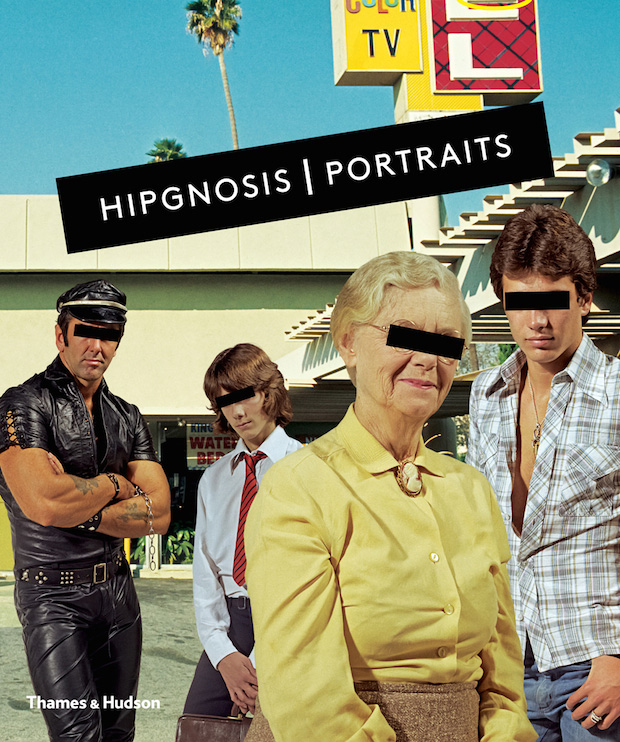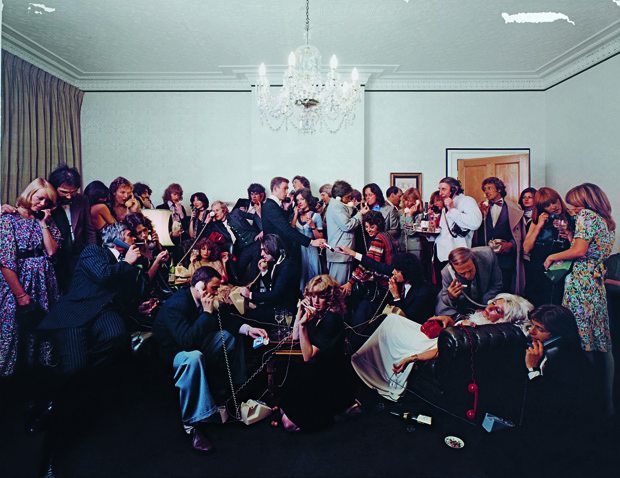A new book unearths the forgotten portrait photography of Hipgnosis, the rebellious and inventive graphic design collective responsible for some of the most innovative and well-known album sleeves of rock’s heyday.

The word ‘iconic' is often overused, bandied about when ‘important’ or ‘recognisable’ would do. But when discussing Hipgnosis, the design collective made up of Storm Thorgerson, Aubrey ‘Po’ Powell and, later, Peter Christopherson, it’s hard to think of a more appropriate word. Not only did the three work with some of the era-defining stars of the late Sixties, Seventies and early Eighties (Led Zeppelin, The Who, Black Sabbath, Pink Floyd) but the album covers they designed were iconography in action. Hipgnosis made manifest the allure and mystery of these demigods and produced visuals so effective that many have surpassed their inspiration. It’s not farfetched, for example, to imagine that more people would be able to recognise the prismatic sci-fi cover of Pink Floyd’s Dark Side of the Moon than the faces of Dave Gilmour or Roger Waters.
New book Hipgnosis – Portraits, written by Aubrey Powell and published by Thames & Hudson, charts some of the rebellious, inventive and often surreal portraiture masterminded and shot by the collective over three decades. For those familiar with Hipgnosis’ work, this might come as a surprise. Iconic their artwork might be, but the threesome were not exactly known for their portraiture. In fact, it was their refusal to just slap band photography on their covers (preferring more abstract or conceptual imagery) that made them so distinctive – and caused so much grief for label bosses, who thought that faces automatically meant more sales. But, as Powell points out in his insightful and touching introduction, part of the contract from many record labels at the time involved photographing the band even if the images were rarely used or even requested. Rather than seeing this as a chore, the team used these shoots to experiment with photography techniques or amusing, often weird, approaches. The result was a huge archive of imagery, much left unopened and untouched since the Seventies. Thorgerson diligently dragged this vast treasure trove with him from office to office, from the crowded chaos of the trio’s Denmark Street studio until long after the dissolution of Hipgnosis in 1983. He and Powell went on to form Greenback Films and Christopherson focused on his music career - namely Psychic TV, which he formed with fellow Throbbing Gristle bandmate Genesis P-Orridge after the seminal industrial band parted ways, and later Coil alongside John Balance.


Powell admits that these rare artefacts – including over one hundred and fifty 35mm negatives of The Rolling Stones, photographs of Paul McCartney & Wings in the Mojave Desert, not to mention a box full of shots of Peter Gabriel naked – had hardly entered his mind until, in the autumn of 2012, Thorgerson found out that he was dying. With a new sense of urgency, the pair (for Christopherson had passed away in 2010) set about unearthing more gems, tracking down lost images from fans and collectors that had somehow got hold of their lost and abandoned work, and moulding them in to some kind of order. Sadly, Thorgerson’s health deteriorated to the point where he couldn’t continue the project and he died before the book was completed but, as he writes in his introduction, Hipgnosis – Portraits helped him and Powell reassess their “sense of inadequacy” over their portraiture portfolio to the point where both had faith that the “images still work their regressive magic”.


A lazier publication would have simply presented Thorgerson and Powell’s finds in full-bleed gloss with captions concerning their subjects and the dates they were taken. Hipgnosis – Portraits defies this perfectly acceptable approach for something altogether more insightful and useful, both for the music fans that one imagines will be the book’s prime audience and keen-eyed creatives alike. Split into two sections, the first, ‘Imagination’, is an alphabetical run-through of the many bands and artists Hipgnosis worked with. Printed on a matt, unbleached stock, this is the behind-the-scenes section, featuring meaty explanations of some of the techniques and processes used to achieve the final shots, not to mention some amusing anecdotes. Alongside Powell’s acumen are numerous roughs, test shots and scraps of inspiration, demonstrating the imagination and skill of the studio. There’s some excellent content here. A black and white image of a F-48 Phantom II with its meticulously arranged payload sits next to a photograph created for the back of Pink Floyd’s Ummagumma, which features the band and huge amount of kit organised in a similar formation. There’s a concept for The Rolling Stones’ Goat’s Head Soup where photos of the bare-chested band had been pasted onto exquisitely drawn horse bodies transforming them into muscular centaurs. Storm Thorgerson features frequently in test shots, most notably with unsettling eyes painted on his closed lids for Sharks’ Jab It in Yore Eye, dressed in a fetching checked jacket, shirt and tie combo (an idea that they sold to Billy Karloff & The Extremes) or getting repeatedly soaked during a water-throwing test in order to ascertain the perfect trajectory for Peter Frampton’s Somethin’s Happening. If you know anything of the trio’s personalities, it will not surprise you to learn that Powell took the photograph and Christopherson was responsible for the bucket.


For the second section ‘Realization’, the book’s designer Peter Curzon (himself a veteran of graphic design for the music industry) switches back to glossy paper, allowing the power of the large-scale photographs to speak for themselves. There’s huge scope in the images, from charming snaps of bands clearly cracking jokes between ‘serious’ shots to artful compositions reminiscent of the studio’s heroes Man Ray, Cartier-Bresson and Edward Steichen. The aforementioned images of Peter Gabriel also make an appearance, tastefully redacted. Shot to appear on the centre label sticker of a record that was actually never released, the concept revolves around (if you’ll excuse the pun) a clever correlation between the photograph and the positioning of the record player’s spindle.
Curzon has done a great job here of balancing the desire to see these impressive images as big as possible with the need to know what we are looking at, creating discreet pointers that nudge the reader towards coverage in the initial ‘Imagination’ section. This cross-referencing plus a detailed index at the back (that even features the image’s original size and the camera used) goes a long way to making the reader feel as though they’re getting the inside scoop into the images’ stories rather than just flicking through glossy photos of rockstars. There’s also a mischievous pairing of images at work. An image of a figure (Lumiere & Son) struggling inside what looks like a duvet cover on a Norfolk beach sits next to a shot of Paul McCartney & Wings on the shore of Owens Lake, California, the form of the ex-Beatle similarly disguised as he shelters from the wind under a striped blanket. John Miles slumps on a window ledge and looks wistfully into the middle distance, while adjacent, Keith Moon reclines on an upholstered velour sofa, staring down the camera, dressed only in a gold medallion and a strategically placed mink stole – the antithesis of Miles’ thoughtful melancholia. These humorous juxtapositions may be happy accidents of the book’s alphabetical system, but one suspects not. With such an incredible subject matter it would be hard to mess this book up, but excellent curation from Powell and design by Curzon have sensitively shown the source material in the best possible light. It’s an excellent resource for designers, photographers and keen amateurs and a fitting tribute to Hipgnosis' skill and imagination.


Hipgnosis – Portraits by Aubrey Powell
Thames & Hudson, £35
thamesandhudson.com






